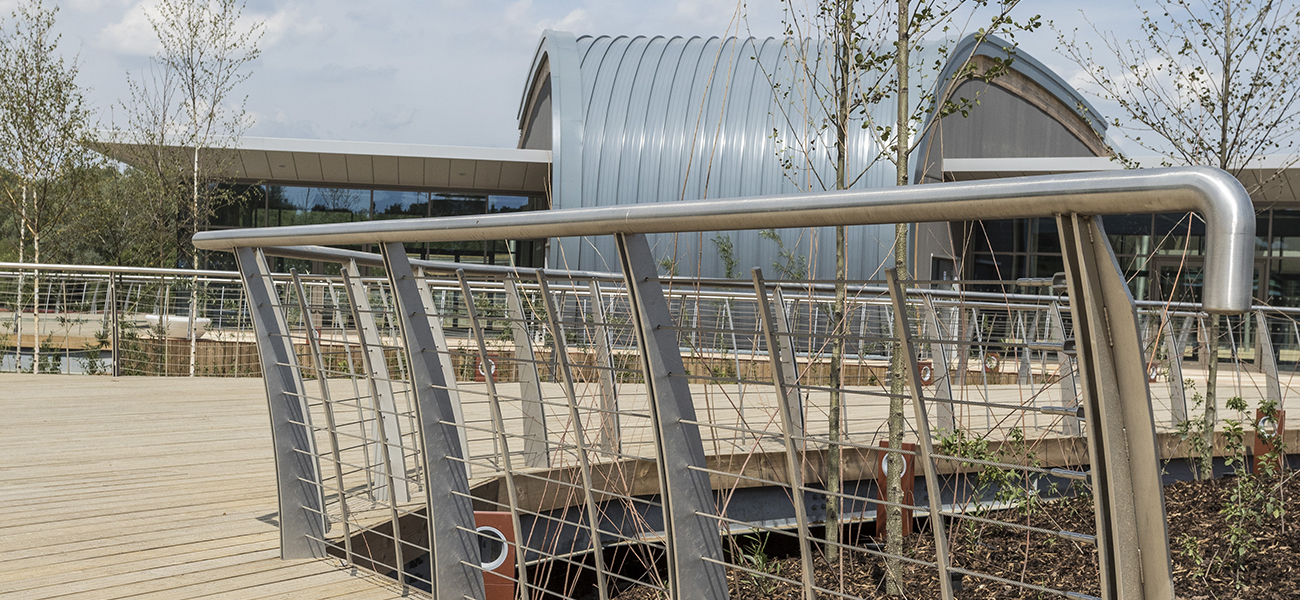Non-slip decking considerations for marina moorings piers and jetties

Decking is often specified for marinas, moorings, piers and jetties, all of which are typically wet environments where timber can be slippery. Therefore specifying for these areas must take into account the high risk, with antislip performance and safety being key considerations for designers.
What material is best for decking in marine environments?
The different materials that can be used for decking for marinas and moorings all have advantages and disadvantages. For example, composites or polyethylene can be lower in cost but react more to changes of temperature and exposure to water than timber, whereas fibreglass decking and resin-bonded panels offer good slip resistance. In addition, metal decks can work well in heavy-duty or commercial applications. Out of all of the options available however, timber decking offers an aesthetic appeal and provides sustainability benefits that can’t be matched.
A popular and durable choice for timber decking is a high-quality, slow grown Northern European Redwood, when correctly pressure-treated for its use. When pressure-treated to Use Class 3 or 4, deck boards perform well as a structural material in river or marine applications.
What ‘Use Class’ should timber decking be treated to?
When purchasing timber decking and associated joists or bearers, a common question is - should I Use Class 3 or Use Class 4 for decking?
In fresh water or marine applications, we typically recommend that timber should be treated to Use Class 4 but the answer depends on where the decking will be used.
Use Class 4 is classified as direct contact with either the ground or freshwater and is one of the most challenging environments for timber and in coastal environments
Use Class 3 applies where the timber is installed fully above the ground. In this application, the wood only needs to be pre-treated to provide extra protection from the elements.
The key consideration here is whether a deck designed for an above-ground application has posts and joists that will be in contact with the ground. Best practice for decking design and installation states that, ‘where posts and joists will be in contact with the ground only Class 4 treatment is fit for purpose - nothing else will do.’ In-ground contact would also apply to joists or bearers that are used for roof decks or balconies, where the bearer is permanently supported.
With the above in mind, it’s important to ensure that the timber for your deck is treated to the appropriate Use Class, not just for the deck boards themselves, but for every element of the structure including posts and joists.
Slip-resistance of decking in marine environments
Decking for marine environments should be specified with high levels of slip resistance. Boards can be castellated (grooved) or smooth with slip resistant inserts. Slip resistant inserts provide significantly better anti-slip performance while retaining the natural beauty of timber. Two or three inserts can be used, depending on the project’s requirements.
Decking should have been independently tested by the Health & Safety Laboratory in accordance with BS 7976, parts 1-3 (2002). CitiDeck and Antislip Plus® have both undergone this testing and significantly exceed the minimum slip requirements.
Durable, low-maintenance decking for marina application
Greenford’s, who deliver civil engineering and landscaping solutions for waterway projects, have used Anti-Slip Plus® deck boards on a number of projects for marinas or inland waterways.
Grove Lock Marina in Leighton Buzzard, Bedfordshire was one of the first projects on which the Oxfordshire-based company used Antislip Plus® deck boards, as part of its refurbishment. After the product proved its performance in terms of slip resistance and low maintenance, Greenford subsequently installing the same specification at Kings Orchard Marina near Lichfield.
“We mainly use slip-resistant decking for pontoons and jetties” says Bob Hutton of Greenford Ltd. “It weathers nicely, blending into the natural landscape. It’s aesthetically pleasing, and the anti-slip inserts complement the deck both visually and in performance. The strength grading allows us to design the deck for the correct loadings. We have the boards pre-cut. The factory cutting saves huge amounts of installation time and as the resin inserts are also pre-fabricated it’s a very time efficient way. The treated timber frame and bearers are set into a steel frame for use in the marina to deliver a strong durable pontoon and jetties.”
Slip-resistant, durable and aesthetic decking for quay
The striking and complex decked pontoon at Herons Quay, Canary Wharf was designed by the landscape architect with three key specification challenges: slip resistance, durability and aesthetics. This incorporated Antisplip Plus Classic timber decking to meet these requirements.
Category: Decking Environmental Technical Timber